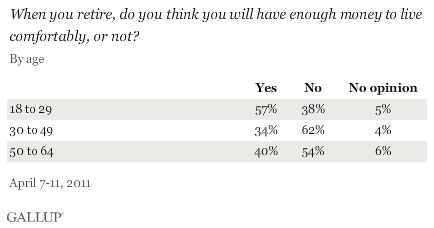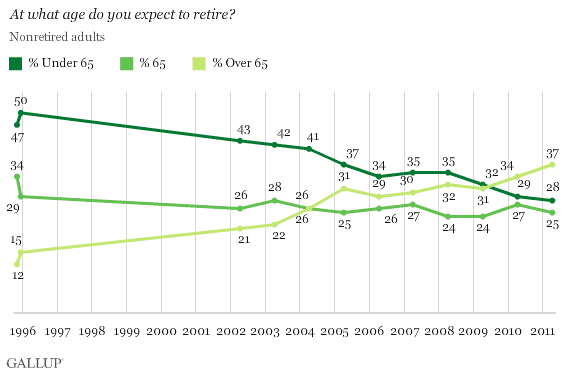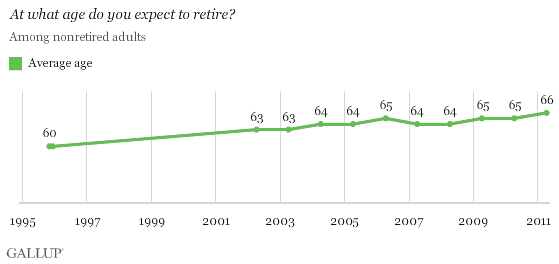PRINCETON, NJ -- A majority of nonretired Americans do not think they will have enough money to live comfortably in retirement, up sharply from about a third who felt this way in 2002. Nonretired Americans now project that they will retire at age 66, up from age 60 in 1995.

When Gallup first asked nonretired Americans in 2002 about their projected retirement resources, they were twice as likely to say they would have enough money to live comfortably as to say they would not -- by a 59% to 32% margin. Those views changed as the decade progressed. By 2009, a majority of Americans said they would not have enough money to live comfortably in retirement. That percentage abated slightly last year, but is up to a new high of 53% in this year's survey, conducted April 7-11.
General economic attitudes affect how Americans look at retirement. Americans were more positive about the overall economy -- and retirement -- prior to the recent recession than they are now. The continuing political discussion about the fragility of the country's Social Security and Medicare programs may also reduce nonretired Americans' comfort with projections of their monetary resources in retirement.
Younger Americans Most Positive
Younger Americans are the most optimistic about having enough money to live comfortably when they retire. They are also the least likely to say they will rely on Social Security as a source of income when they retire. This suggests that young Americans are looking optimistically toward other sources of income in retirement.

Those closest to retirement age, 50- to 64-year-olds, are slightly more positive about having enough money in retirement than those who are 30 to 49.
Nonretired Adults Now Project a Retirement Age of 66
Nonretired Americans now project a higher retirement age than in previous years. When Gallup first asked nonretired adults in 1995 when they expected to retire, 12% said they would retire after age 65. That percentage is now up to 37%. The percentage saying they will retire before age 65 is down from 47% in 1995 to 28% today. (See the trend in greater detail on page 2.)

Looked at differently, nonretired Americans' average projected retirement age is up from 60 in 1995 to 66 today. This could reflect nonretirees' increasingly pessimistic attitudes about having enough money when they do quit working, as well as changes that increase the age at which a worker can collect full Social Security benefits.

Implications
Social Security and Medicare are huge components of the federal budget. With baby boomers fast aging into retirement years, these programs' share of federal spending will increase proportionately in the years to come. It is not surprising that elected representatives are beginning to look to changes in these entitlement programs as one way to reduce spending and reduce the deficit in the years ahead.
The majority of Americans disapprove of efforts to cut these programs. The current research showing that the majority of nonretired Americans are worried they will not have enough money to live comfortably when they retire may help explain their disapproval. Additionally, other Gallup research has shown that Social Security is the most important source of income for Americans who are now retired.
At the same time, 6 in 10 workers hold out little hope of receiving Social Security benefits. This suggests that cutting back on the system might not be a totally unexpected move as far as workers are concerned, and that there might be less political resistance to such changes than some might think.
The attitudes of younger Americans present somewhat of a paradox. Those under age 30 are both most optimistic about having enough money in their retirement years and least optimistic that they will receive Social Security. This suggests that younger workers are already planning on other sources of retirement income, and are -- perhaps unrealistically -- assuming that they will amass enough money on their own to handle their retirement in the decades ahead.
Survey Methods
Results for this Gallup poll are based on telephone interviews conducted April 7-11, 2011, with a random sample of 1,077 adults, aged 18 and older, living in the continental U.S., selected using random-digit-dial sampling.
For results based on the total sample of national adults, one can say with 95% confidence that the maximum margin of sampling error is ±4 percentage points.
Interviews are conducted with respondents on landline telephones and cellular phones, with interviews conducted in Spanish for respondents who are primarily Spanish-speaking. Each sample includes a minimum quota of 400 cell phone respondents and 600 landline respondents per 1,000 national adults, with additional minimum quotas among landline respondents for gender within region. Landline telephone numbers are chosen at random among listed telephone numbers. Cell phones numbers are selected using random digit dial methods. Landline respondents are chosen at random within each household on the basis of which member had the most recent birthday.
Samples are weighted by gender, age, race, Hispanic ethnicity, education, region, adults in the household, and phone status (cell phone-only/landline only/both, cell phone mostly, and having an unlisted landline number). Demographic weighting targets are based on the March 2010 Current Population Survey figures for the aged 18 and older non-institutionalized population living in U.S. telephone households. All reported margins of sampling error include the computed design effects for weighting and sample design.
In addition to sampling error, question wording and practical difficulties in conducting surveys can introduce error or bias into the findings of public opinion polls.
View methodology, full question results, and trend data.
For more details on Gallup's polling methodology, visit www.gallup.com.

